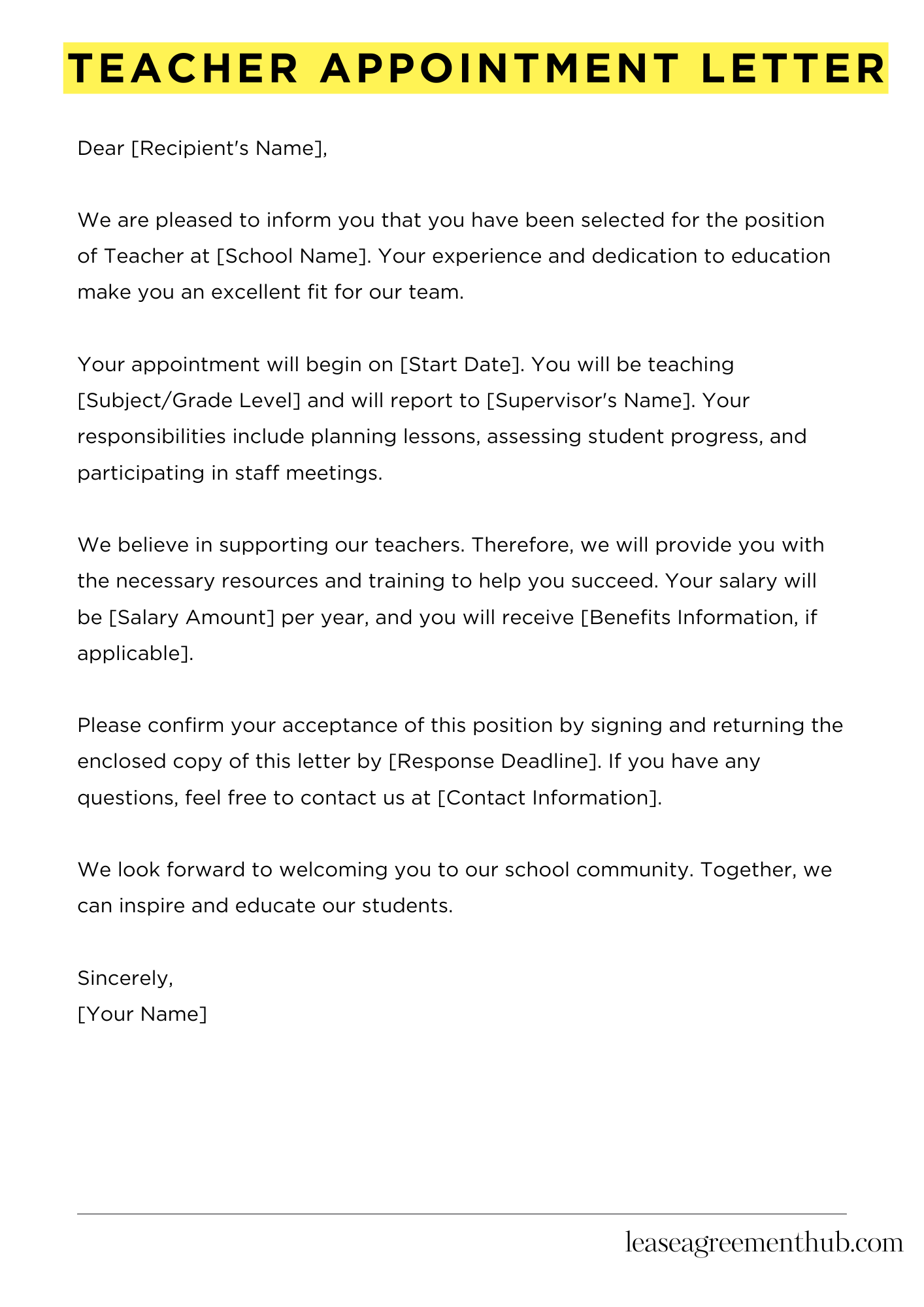A Teacher Appointment Letter is a formal document that confirms a teacher’s employment with a school or educational institution. Its main purpose is to outline the terms of employment, including job responsibilities, salary, and start date. This letter serves as an official record for both the teacher and the school, ensuring clarity in the employment relationship.
In this article, we will provide various templates and examples of Teacher Appointment Letters. These samples are designed to help you easily create your own letter. Whether you are a school administrator or a teacher, you will find useful formats that simplify the writing process.
By using our templates, you can save time and ensure that your letter includes all necessary details. This resource aims to make your experience smoother and more efficient. You will have the tools to craft a professional appointment letter with ease.
Teacher Appointment Letter
[Your School’s Letterhead]
[School Name]
[School Address]
[City, State, Zip Code]
[Email Address]
[Phone Number]
[Date]
[Recipient’s Name]
[Recipient’s Address]
[City, State, Zip Code]
Dear [Recipient’s Name],
We are pleased to inform you that you have been selected for the position of Teacher at [School Name]. Your experience and dedication to education make you an excellent fit for our team.
Your appointment will begin on [Start Date]. You will be teaching [Subject/Grade Level] and will report to [Supervisor’s Name]. Your responsibilities include planning lessons, assessing student progress, and participating in staff meetings.
We believe in supporting our teachers. Therefore, we will provide you with the necessary resources and training to help you succeed. Your salary will be [Salary Amount] per year, and you will receive [Benefits Information, if applicable].
Please confirm your acceptance of this position by signing and returning the enclosed copy of this letter by [Response Deadline]. If you have any questions, feel free to contact us at [Contact Information].
We look forward to welcoming you to our school community. Together, we can inspire and educate our students.
Sincerely,
[Your Name]

How to Write Teacher Appointment Letter
Understanding the Purpose of the Letter
A teacher appointment letter is an official document that confirms a teacher’s employment with a school or educational institution. This letter serves multiple purposes. It provides clarity about the terms of employment, outlines the responsibilities of the teacher, and sets the tone for the working relationship. Understanding this purpose is crucial before you start writing.
Gathering Necessary Information
Before drafting the letter, collect all relevant information. This includes the teacher’s full name, the position they are being appointed to, the start date, and the salary details. Additionally, gather information about the school or institution, such as its name, address, and any specific policies that should be mentioned. Having this information at hand will make the writing process smoother.
Structuring the Letter
The structure of the appointment letter is important for clarity. Start with a formal greeting, such as “Dear [Teacher’s Name].” Follow this with a clear statement of appointment. For example, “We are pleased to offer you the position of [Position] at [School Name].” Next, include details about the terms of employment, such as the start date, salary, and work hours. Finally, conclude with a warm closing, encouraging the teacher to reach out with any questions.
Using Clear and Professional Language
When writing the letter, use clear and professional language. Avoid jargon or overly complex sentences. The goal is to ensure that the teacher understands their appointment without confusion. Use positive and welcoming language to create an encouraging tone. Remember, this letter is not just a formality; it sets the stage for the teacher’s experience at the school.
Reviewing and Finalizing the Letter
After drafting the letter, take the time to review it carefully. Check for any spelling or grammatical errors. Ensure that all the information is accurate and clearly presented. It may be helpful to have someone else read the letter as well. Once you are satisfied with the content, print it on official letterhead and sign it. This final touch adds professionalism and authenticity to the document.
Related: